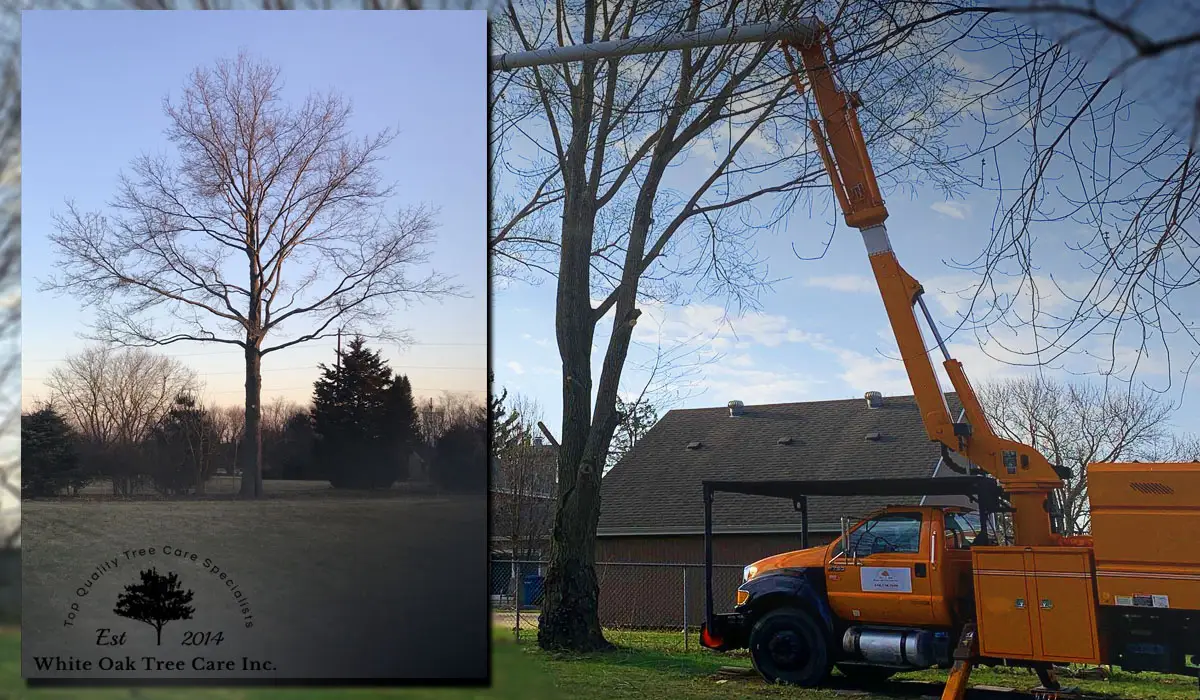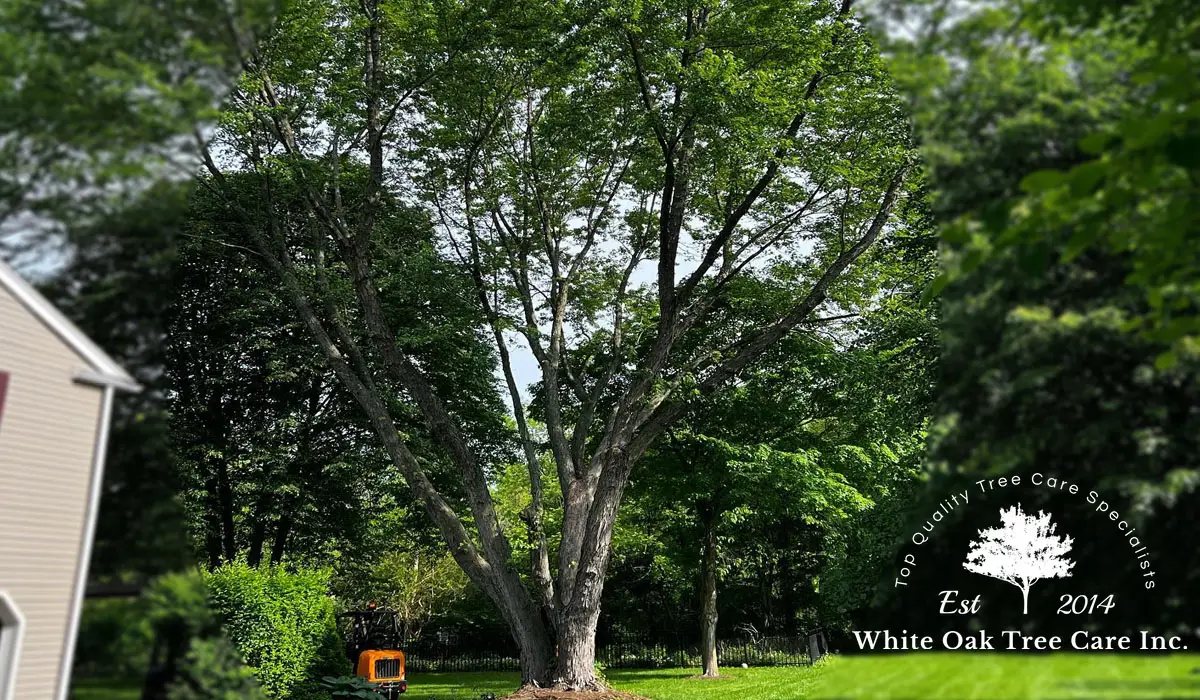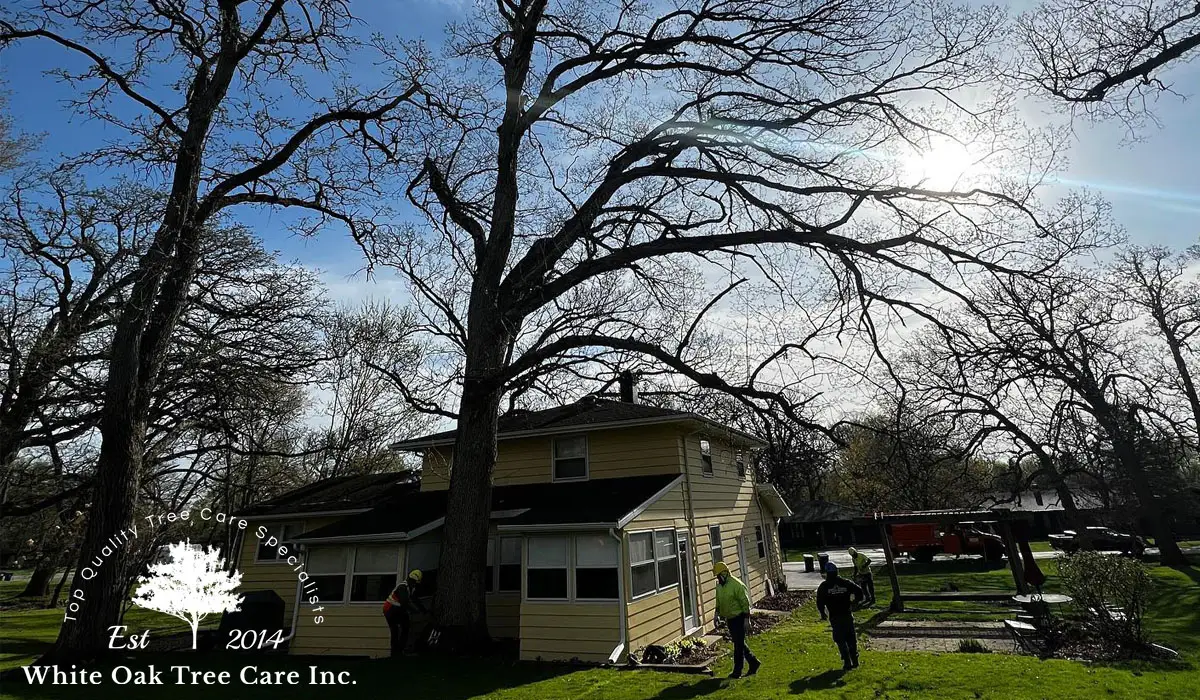
Tree Health 101: Understanding Common Tree Diseases And Treatments
Guide To Understanding Tree Health, Diseases, And Treatments
It is essential to know about the most common tree diseases. It’s done to ensure they stay beautiful and last long. This article will examine some of the most common tree diseases. We’ll also talk about how these diseases can be treated and how they can be stopped. White Oak Tree Care Inc. knows how important healthy trees are. Because of this, we offer full tree care services. We want your trees to be strong, healthy, and lovely. Our certified arborists will provide a tree health assessment to ensure we will treat it properly. So you can feel safe knowing your trees are in good hands.
Will you take the first step toward making trees healthier? Then please call us immediately at (630) 520-2690 to schedule a meeting. Our team is here to help you keep your trees healthy and beautiful so you can enjoy them for years to come.
Understand Tree Health, Including Tree Diseases And Treatments
Trees help to clean the air we breathe, which is good for the environment. Like any other living thing, trees can get sick and die if they aren’t taken care of quickly. To keep the trees in our towns and cities healthy, we must know how to treat common tree diseases.
1. Understanding Common Tree Diseases
You must first know what they are to find and get rid of the most common tree diseases. Here are some of the most common diseases that affect trees:
Dutch Elm Disease
Elm trees are hurt by Dutch Elm Disease, which is caused by a fungus. It spreads quickly and could kill a tree in a few years by making it lose its leaves and die. Elm bark beetles spread it, but it can be stopped if trees are cared for and managed well. Fungicides can be used to treat the tree, or it can be cut down or pruned.
Oak Wilt
A fungus causes this severe tree disease. It spreads through roots that grow together or through beetles that feed on sap. It makes leaves fall off and kill many different kinds of oak trees. Even though oak wilt can’t be fixed, healthy trees can be kept safe by taking care. One example is not cutting back the plants during the warm months. The other is to plant plants that are resistant to disease. Finding and treating oak wilt as soon as possible is essential to stop it from spreading to other trees.
Pine Wilt Disease
Nematodes spread pine wilt disease, which is a disease that kills trees. A certain kind of beetle carries these. It mostly kills pine trees by making their needles turn brown and their branches droop. Even though there is no known cure, there are things that can be done to stop the disease from getting worse. For example, infected trees can be cut down, which will reduce the number of beetles. You can’t say enough about how important early detection is.
Apple Scab
Apple scab is a fungus that stops apple trees from making as many apples. It causes sores on the fruits and spots on the leaves. Spores help it spread, but it can be stopped. Resistant plant cultivars cut off infected leaves and use fungicides. To prevent a disease from spreading, finding it as soon as possible is essential.
Cedar Rust
Cedar rust is a fungus that attacks cedar and juniper tree leaves and branches. It can make the needles turn yellow and the leaves fall off too soon. It can also cause spots on the needles that are brown or black. Spores spread the disease, which can be stopped by taking care of the trees and using fungicides.
Anthracnose
Anthracnose is a disease spread by fungi and leads to leaf blight and cankers on the branches and twigs of trees. It usually happens when it is cool and wet, and in the worst cases, it can kill a lot of leaves.

Fire Blight
Fire blight is an infection caused by bacteria that affects mainly apple, pear, and quince trees. It makes the tree’s leaves, branches, and twigs turn brown and die, killing the tree. Bugs, rain, and pruning tools can spread the bacteria. Most of the time, antibiotics or removing the infected parts of the tree are enough to treat the disease.
Powdery Mildew
Powdery mildew is a disease caused by fungi that can affect trees and other plants. On the tree’s leaves, stems, and flowers, it looks like a white or grayish powder. It could slow down growth and make leaves fall off too soon. Spores that spread disease can be stopped. You should prune and make sure there is enough airflow. It would help if you also used treatments that kill fungi.
Find out what the most common diseases of trees are and how they show up. You have to take the necessary steps to stop them from spreading. You can also ensure your trees don’t get hurt or die. You should talk to an arborist if you think your tree is sick. They can give you expert advice and treatment options that are right for your tree.
2. Identifying Tree Diseases
The best way to figure out what’s wrong with a tree is to look closely at what’s wrong with it. Here are some signs that a tree has a common disease:
- Leaf spotting or discoloration.
- Branches and leaves that are dying or falling over.
- Leaves turning yellow or brown.
- A leaf that fell too soon.
- Bark that is split or coming off.
- The trunk or branches change or lose their color.
- Branches and twigs that are no longer alive.
- Bugs or other kinds of bugs are in the area.
If your tree does any of these things, it could be a sign of disease, so you should act quickly.
3. Treating And Preventing Tree Diseases
Bacteria, viruses, fungi, and other tiny organisms can cause tree diseases. They can get weaker or die from these diseases. This can mean less shade, less beauty, and even damage to your property. Because of this, it is essential to treat and stop tree diseases. Here are some suggestions:
Keep Your Soil In Good Shape
You can stop diseases in trees if the soil is in good shape. It should be easy to drain, have the right pH level, and give the tree everything it needs to grow. Adding organic matter and aerating the soil on a regular basis can make it healthier. People who walk on the ground, use heavy equipment, or build should not pack the soil down. The tree’s nutritional needs can be met in part by testing the soil and giving it fertilizer.
Plant Disease-Resistant Trees
If you plant trees that can’t get common tree diseases, they won’t come to your yard. When you plant trees that don’t get sick, there are a few things to remember:
- Choose The Right Tree Species
Some tree species naturally don’t get sick from certain diseases. Apple scab does not hurt crabapple trees, for example, and pine wilt does not hurt redwood trees. Find out about the different kinds of trees. Choose ones that are resistant to diseases that are common in your area.
- Plant In The Right Location
When trees are planted in the wrong place, they get stressed, which makes them more likely to get sick. Plant trees resistant to disease in areas with enough sunlight, good drainage, and minor flooding.
- Properly Maintain Trees
You can help trees stay healthy by giving them enough water and fertilizer and cutting back their branches. Check your trees often for signs of disease, and if you find any, do what you need to do.

- Use Disease-Resistant Rootstock
It would help to consider using disease-resistant rootstock when planting fruit trees. So, diseases can’t get into the tree through its roots.
Following these tips and planting trees that don’t get sick quickly can help protect your yard from common tree diseases. You can also ensure that your landscape looks nice and stays healthy for a long time.
Use Clean Equipment
Keep your pruning tools clean to stop the spread of diseases that hurt trees. Use rubbing alcohol or bleach to clean the blades before and after each use. When it’s raining, you shouldn’t prune. Clean tools help keep trees healthy and free of disease.
Remove Infected Wood
You must take away infected wood to stop the spread of tree diseases. Use clean pruning tools to make a clean cut and return all diseased wood to healthy tissue. To prevent the spread of illness, you should get rid of infected wood the right way. Check trees regularly for signs of infection. Remove infected wood as soon as possible to keep them healthy.
Practice Good Hygiene
Good hygiene is essential to stop the spread of tree diseases. Don’t put your hands in your face or mouth; wear gloves instead. Before and after you work with trees, you should wash your hands. Don’t walk or drive on the ground near trees to keep the soil from getting packed down. Clean the tools before and after each use. Trees stay healthy and free of diseases when they are clean.
Use Proper Irrigation
To keep trees from getting sick, they need to get enough water. Water deeply and less often, giving the soil a little time to dry out between waterings. Use a soaker hose or drip irrigation to add water slowly and evenly. You shouldn’t water your plants if it is raining or very humid. The best time to water trees is first thing in the morning or late at night. Check for signs that the trees are getting too much or too little water. Change the amount of watering as needed. When trees get enough water, they are less stressed and less likely to get sick.
Apply Organic Mulch
Putting organic mulch around trees is an excellent way to keep them healthy and stop tree diseases from spreading. Organic mulch regulates soil temperature and moisture. This makes the roots stronger and lessens the stress on the tree. Put a 2–4-inch layer of organic material around the tree’s base, but not on the trunk, to keep water from building up.
Organic mulch also stops the growth of weeds, improves the health of the soil, and adds organic matter to it. Use less inorganic mulch. Trees are less likely to get sick when there is organic mulch around.
Control Pests
Pests like insects and rodents can weaken trees and make them more likely to get sick. You can use integrated pest management practices to get rid of pests. Depending on the situation, it means using either natural predators or insecticides.
Prune Properly
Trees stay healthy and don’t get sick when they are pruned. Use sharp tools to make clean cuts at a 45-degree angle just outside the branch collar. When the plant isn’t growing, you should prune it so it doesn’t get stressed and moldy. A tree can be hurt by too much pruning. By cutting off dead or sick branches, you can improve the tree’s shape and let more air flow through. This makes it less likely that fungus will grow.
Consult An Expert
Talk to a certified arborist or professional that offers tree health services if your tree is sick or dying. They can determine what’s wrong and suggest the best way to fix it. It can be hard to tell if a tree has one of these diseases, and if you don’t know how to treat it, you could worsen the problem. Someone caring for trees can also tell you how to keep trees healthy and disease-free. They can look for possible dangers and give suggestions. Talking to a professional can help you avoid damage or removal that will cost a lot of money.
Trees are an essential part of our environment. So, keeping them healthy is very important if you want them to live a long time. The first step to ensuring trees are healthy is learning about common tree diseases and how to treat them. By following the advice, you can avoid getting sick. You can also keep your trees healthy and beautiful. Remember that prevention is better than treatment!
White Oak Tree Care Inc. is committed to providing tree health care services of the highest quality. We will help you make sure your trees stay healthy and grow well. Our experts can find and treat a wide range of diseases that affect trees. We use cutting-edge techniques and tools to make sure that our treatment works. So, if you want a trustworthy partner to help you keep your trees healthy, give us a call today at (630) 520-2690 to get a quote. Please don’t be afraid to get in touch with us for all your tree care needs. We’re here to ensure your trees get the best care possible.
Other Services Offered:
Other Articles We’ve Hand-Picked For You:
Frequently Asked Questions
Common tree diseases include Dutch elm disease, oak wilt, apple scab, powdery mildew, and cedar rust. These diseases can cause various symptoms, such as leaf discoloration, wilting, cankers, and fungal growth.
Look for signs such as leaf spots, abnormal leaf color or shape, wilting, premature leaf drop, cankers, growth abnormalities, or pests. It is also helpful to consult a professional arborist who can accurately diagnose the disease based on visual examination and laboratory tests.
Tree diseases can sometimes be treated or managed to prevent further damage and promote tree health. Treatment options may include pruning affected branches, applying fungicides or other medications, improving soil conditions, or implementing cultural practices that enhance tree vigor.
To prevent the spread of tree diseases, practice good sanitation by promptly removing and disposing of diseased plant material. Avoid pruning or working with trees when wet, as moisture can transmit disease. Proper tree care practices, such as regular watering and fertilization, can also help strengthen trees and make them more resilient to diseases.
It is advisable to seek professional help from a certified arborist when dealing with tree diseases. They have the expertise to diagnose the issue accurately, recommend appropriate treatments, and provide guidance on tree care practices. Additionally, they can ensure the tree’s and surrounding landscape’s safety during the treatment process.
